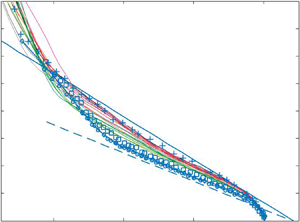Article contents
Revisiting rough-wall turbulent boundary layers over sand-grain roughness
Published online by Cambridge University Press: 28 January 2021
Abstract

This study examines the flow characteristics of a turbulent boundary layer over different sand-grain roughness created by P $24$ and P
$24$ and P $36$ and P
$36$ and P $60$ sandpapers. The experimental dataset is acquired with high-resolution planar particle image velocimetry in the streamwise–wall-normal plane for a range of Reynolds number between
$60$ sandpapers. The experimental dataset is acquired with high-resolution planar particle image velocimetry in the streamwise–wall-normal plane for a range of Reynolds number between  $\delta ^+=1200\text {--}6300$, which consists of a number of transitionally and fully rough flow conditions where
$\delta ^+=1200\text {--}6300$, which consists of a number of transitionally and fully rough flow conditions where  $30\leq \delta /k_s\leq 111$. The conditions formed over different rough surfaces (having identical surface morphology) enable us to compare rough flows at matched
$30\leq \delta /k_s\leq 111$. The conditions formed over different rough surfaces (having identical surface morphology) enable us to compare rough flows at matched  $k_s^+$ or
$k_s^+$ or  $\delta ^+$ (roughness Reynolds number and Kármán number, respectively), including matched conditions from other studies in the literature. For all the cases, the friction velocity is determined from the direct wall shear-stress measurements using a floating-element drag balance. Mean streamwise velocity profiles exhibit a logarithmic behaviour in the inertial region, and their defect forms are observed to collapse in the outer layer even for the transitionally rough cases at relatively low Reynolds numbers. However, the diagnostic plot of the streamwise velocity intensity suggests that the wall similarity only holds for
$\delta ^+$ (roughness Reynolds number and Kármán number, respectively), including matched conditions from other studies in the literature. For all the cases, the friction velocity is determined from the direct wall shear-stress measurements using a floating-element drag balance. Mean streamwise velocity profiles exhibit a logarithmic behaviour in the inertial region, and their defect forms are observed to collapse in the outer layer even for the transitionally rough cases at relatively low Reynolds numbers. However, the diagnostic plot of the streamwise velocity intensity suggests that the wall similarity only holds for  $k_s^+\geq 75(\Delta U^+\geq 7)$. Analyses at several matched
$k_s^+\geq 75(\Delta U^+\geq 7)$. Analyses at several matched  $\delta ^+$ cases show that the mean streamwise velocity defect and turbulence profiles (streamwise and wall-normal velocity variances and the Reynolds shear stress) are self-similar in the outer layer independent of the surface roughness. This similarity extends closer to the wall for the wall-normal velocity variances and Reynolds shear-stress profiles for the weaker roughness (lower
$\delta ^+$ cases show that the mean streamwise velocity defect and turbulence profiles (streamwise and wall-normal velocity variances and the Reynolds shear stress) are self-similar in the outer layer independent of the surface roughness. This similarity extends closer to the wall for the wall-normal velocity variances and Reynolds shear-stress profiles for the weaker roughness (lower  $k_s$), which could be a result of higher
$k_s$), which could be a result of higher  $\delta /k_s$ for these cases compared with the P
$\delta /k_s$ for these cases compared with the P $24$ grit sandpaper. For the matched
$24$ grit sandpaper. For the matched  $k_s^+$ conditions, all the profiles were observed to collapse better for fully rough conditions. However, in the transitionally rough regime, the current turbulence statistics are observed to deviate in the outer layer from those reported in other studies (Squire et al., J. Fluid Mech., vol. 795, 2016, pp. 210–240; Morrill-Winter et al., Phys. Rev. Fluids, vol. 2, 2017, 054608). Higher values of roughness function, turbulence intensity and Reynolds shear stress in the current study could be due to overstimulation of the boundary layer. Despite the differences in the turbulence profiles observed, the average large-scale structures across all wall-normal locations are found to be independent of
$k_s^+$ conditions, all the profiles were observed to collapse better for fully rough conditions. However, in the transitionally rough regime, the current turbulence statistics are observed to deviate in the outer layer from those reported in other studies (Squire et al., J. Fluid Mech., vol. 795, 2016, pp. 210–240; Morrill-Winter et al., Phys. Rev. Fluids, vol. 2, 2017, 054608). Higher values of roughness function, turbulence intensity and Reynolds shear stress in the current study could be due to overstimulation of the boundary layer. Despite the differences in the turbulence profiles observed, the average large-scale structures across all wall-normal locations are found to be independent of  $k_s^+$ and
$k_s^+$ and  $\delta ^+$.
$\delta ^+$.
- Type
- JFM Papers
- Information
- Copyright
- © The Author(s), 2021. Published by Cambridge University Press
References
REFERENCES
- 11
- Cited by



